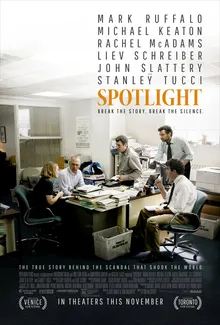Historical accuracy of Spotlight

Historical accuracy of Spotlight

Characters
Walter "Robby" Robinson
Robinson was the real editor leading the Boston Globe's Spotlight team during the investigation. The film accurately portrays his leadership and journalistic approach.
Michael Rezendes
Rezendes was a real member of the Spotlight team known for his dogged pursuit of the story, particularly in obtaining crucial documents. His portrayal reflects his real journalistic methods and dedication.
Sacha Pfeiffer
Pfeiffer was a real member of the Spotlight team who conducted many sensitive interviews with survivors. Her depiction as a compassionate and skilled interviewer is accurate.
Matt Carroll
Carroll was a real member of the Spotlight team who focused on analyzing data, such as priest directories, to uncover patterns. His role in the data-driven aspect of the investigation is accurately portrayed.
Ben Bradlee Jr.
Bradlee Jr. was the real Assistant Managing Editor supervising the Spotlight team during the investigation. His oversight role is depicted accurately.
Marty Baron
Baron was the real editor who arrived at the Globe in 2001 and initiated the Spotlight investigation into the Church abuse scandal. His crucial role as an outsider pushing the story forward is accurate.
More characters
Mitchell Garabedian
Garabedian is a real attorney who represented numerous victims of clergy abuse. His tenacious legal work and initial reluctance to trust the Globe are accurately based on his real experiences.
Eric MacLeish
MacLeish is a real attorney who handled many settlements between victims and the Archdiocese. The film depicts his role, though MacLeish himself has disputed aspects of his portrayal regarding confidentiality.
Jim Sullivan
This character represents lawyers defending the Archdiocese, primarily based on the role played by the real attorney Wilson D. Rogers Jr., though the name is changed.
Cardinal Bernard Law
Law was the real Archbishop of Boston during the scandal. The film accurately portrays his position of authority and the subsequent findings of his role in covering up abuse cases.
Phil Saviano
Saviano was a real survivor of clergy abuse and founder of the Survivors Network of those Abused by Priests (SNAP). His crucial role in providing information and advocating for victims is accurately shown.
Joe Crowley
Joe Crowley is based on a real survivor who shared his story with the Spotlight team, contributing to their understanding of the abuse pattern.
Patrick McSorley
Patrick McSorley is based on a real survivor whose testimony was part of the Globe's investigation into abusive priests like John Geoghan.
Story
The Boston Globe's investigation
The film accurately portrays the Boston Globe's investigation into the Catholic Church sex abuse scandal. The Spotlight team's dedication, their meticulous research, and their efforts to uncover the truth are well-represented.
The scale of the abuse scandal
The film effectively conveys the shocking scale of the abuse scandal, revealing the systemic cover-up and the widespread nature of the abuse. The film's depiction of the number of victims and the extent of the Church's involvement is consistent with historical accounts.
The role of the Catholic Church
The film accurately portrays the Catholic Church's role in covering up the abuse and protecting the perpetrators. The film shows how the Church's hierarchy, including Cardinal Law, enabled the abuse to continue for decades.
The experiences of the victims
The film gives voice to the victims of abuse, showing the devastating impact of the abuse on their lives. The film's portrayal of the victims' trauma and their struggles to seek justice is sensitive and realistic.
The role of the Boston Globe reporters
The film accurately portrays the dedication and perseverance of the Boston Globe reporters, including Walter Robinson, Sacha Pfeiffer, Mike Rezendes, and Matt Carroll. Their commitment to uncovering the truth is a key element of the story.
The challenges faced by the reporters
The film depicts the challenges faced by the reporters, including the resistance from the Church, the difficulty of getting victims to come forward, and the pressure to publish the story. These obstacles are realistically portrayed.
The role of the editor, Marty Baron
Marty Baron's role as the editor who initiated and supported the investigation is accurately portrayed. His commitment to journalistic integrity and his willingness to challenge powerful institutions are well-represented.
The impact of the investigation
The film accurately depicts the significant impact of the Boston Globe's investigation, which led to the resignation of Cardinal Law and sparked a global reckoning with the issue of sexual abuse in the Catholic Church.
The portrayal of the legal system
The film touches upon the role of the legal system in the abuse scandal, including the settlements reached with victims and the challenges of prosecuting perpetrators. However, the legal complexities are simplified for the narrative.
The film's focus on investigative journalism
The film celebrates the importance of investigative journalism and its role in holding powerful institutions accountable. The Spotlight team's dedication to uncovering the truth is a central theme and is portrayed with admiration.
Setting
The depiction of the Boston community
The film effectively portrays the Boston community, including the strong influence of the Catholic Church and the reactions of the public to the revelations of abuse. The film captures the sense of betrayal and shock experienced by many Bostonians.
The film's overall tone and message
The film's overall tone is serious and respectful, reflecting the gravity of the subject matter. It avoids sensationalism and focuses on the facts of the case, the experiences of the victims, and the importance of seeking justice.
